By Victor Ciardha. https://www.nmn.com/news/chinese-study-shows-nmn-enhances-new-potential-therapy-for-heart-attack-damage
Vesicles secreted from NMN-treated stem cells improve heart function while promoting blood vessel formation and reducing tissue damage after myocardial infarction (heart attack) in rats.
Heart tissue damage and scarring (blue) after heart attack (left) is reduced by vesicles secreted from NMN-conditioned stem cells (right).
Highlights:
Heart attacks account for 80% of deaths resulting from heart disease, the leading cause of death worldwide. Heart attacks are caused by cell oxygen deprivation due to blood vessel blockage, leading to fatal levels of heart tissue damage. In an effort to prevent death, it is critical to restore blood flow and repair this tissue damage as soon as possible. Current options include surgery or medications like aspirin.
Now, Pu and colleagues from The First Affiliated Hospital of Nanjing Medical University in China report in Stem Cell Reviews and Reports that vesicles secreted from stem cells treated with NMN (N-Vs) may reduce heart damage and dysfunction after heart attack. Namely, in a heart attack rat model, N-V injections improve heart function, increase blood vessel formation, and reduce tissue damage. These results suggest that stem cell-derived vesicles, especially when conditioned with NMN, can reduce heart damage from heart attack.
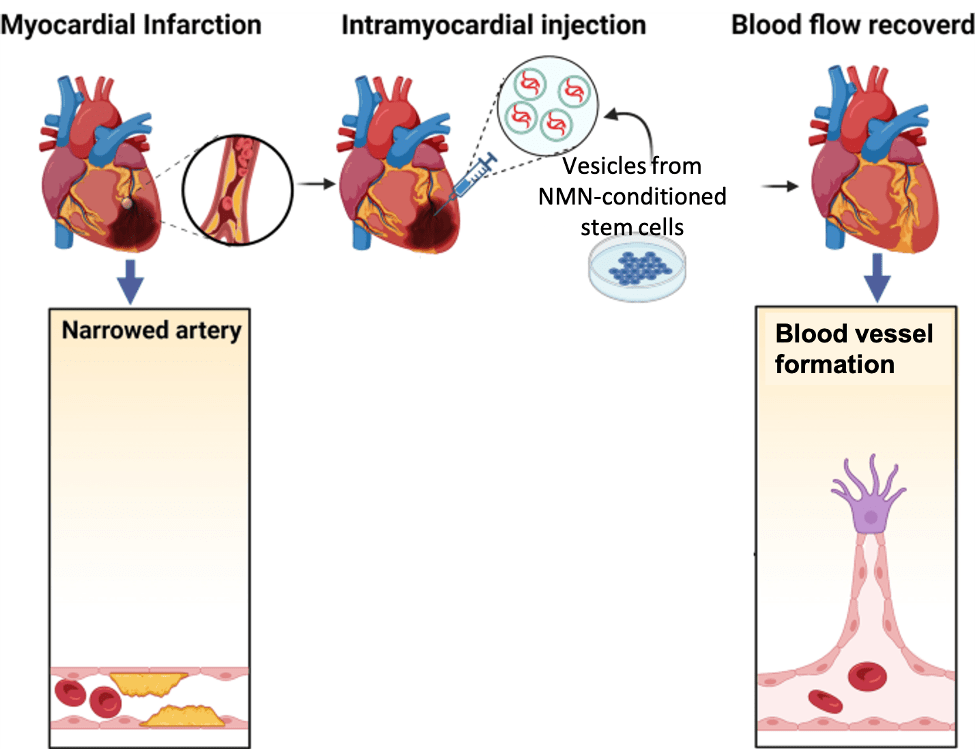
(Pu et al., 2023 | SCRR) Graphical Summary. Myocardial infarction (heart attack) is induced by artery blockage. Injecting damaged heart tissue with vesicles from stem cells treated with NMN reduces heart tissue damage and increases blood vessel formation.
NMN Enhances Stem Cell Vesicle Heart Repair
Recent studies have indicated that stem cells (mesenchymal stem cells) secrete membrane-bound sacs called extracellular vesicles that are filled with potentially therapeutic molecules. Like stem cells, these vesicles possess curative properties. They also have advantages over stem cells, including a lack of immune system rejection and tumor induction. When conditioned with various stimuli, stem cell vesicle content can change, influencing their biological effect.
Pu and colleagues surgically induced coronary artery blockage in rats to cause heart tissue damage and simulate a heart attack. They then injected the rats at the border of the tissue damage with untreated stem cell vesicles or NMN-treated stem cell vesicles. After four weeks, they found that untreated vesicles increased left ventricular ejection fraction — the fraction of blood pumped by the heart. Moreover, N-Vs increased the ejection fraction further, indicating enhancement of heart function repair.
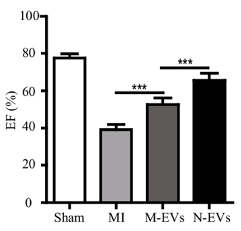
(Pu et al., 2023 | SCRR) NMN Conditioning Improves Stem Cell Vesicle-Mediated Heart Function Recovery. Following heart attack (MI), the ejection fraction (EF) % of the left ventricle is lower than normal (Sham). Vesicles from stem cells (M-EVs) increase the ejection fraction, indicating improved heart function. The ejection fraction is further increased when stem cells are first conditioned with NMN (N-EVs).
The pumping-action of the heart is most efficient when blood flow, mediated by blood vessels, is optimal. Pu and colleagues found that untreated stem cell vesicles increased small artery and capillary density in the heart tissue of rats following heart attack. Additionally, artery and capillary blood vessel density were further increased by N-Vs. These findings demonstrate that NMN enhances vesicle-mediated blood vessel formation, which should increase blood flow.
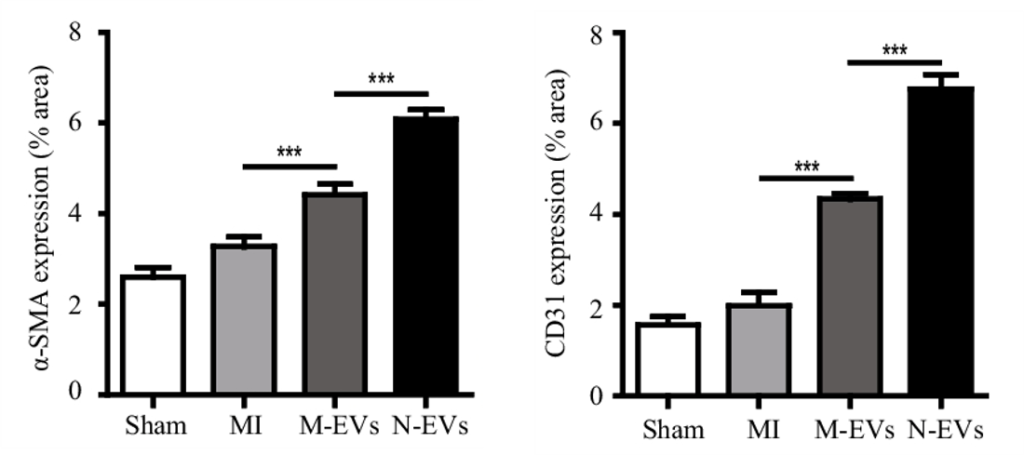
(Pu et al., 2023 | SCRR) NMN Conditioning Improves Stem Cell Vesicle-Mediated Blood Vessel Formation. Compared to normal (Sham), heart attack (MI) insignificantly increases small artery (identified with α-SMA expression, left) and capillary (identified with CD31 expression right) formation to promote tissue recovery. Vesicles from stem cells (M-EVs) significantly (***) increase blood vessel formation, which is further enhanced when stem cells are first conditioned with NMN (N-EVs).
New blood vessel formation contributes to reduced tissue scarring —fibrosis — and cell death in cardiac tissue damaged by heart attack. Pu and colleagues found that fibrosis decreased in response to untreated stem cell vesicles, and that fibrosis decreased more with N-Vs. Furthermore, programmed cell death — apoptosis — was reduced by normal vesicle injections and again reduced by N-V exposure. These findings indicate that NMN enhances stem cell vesicle-mediated cardiac tissue repair.
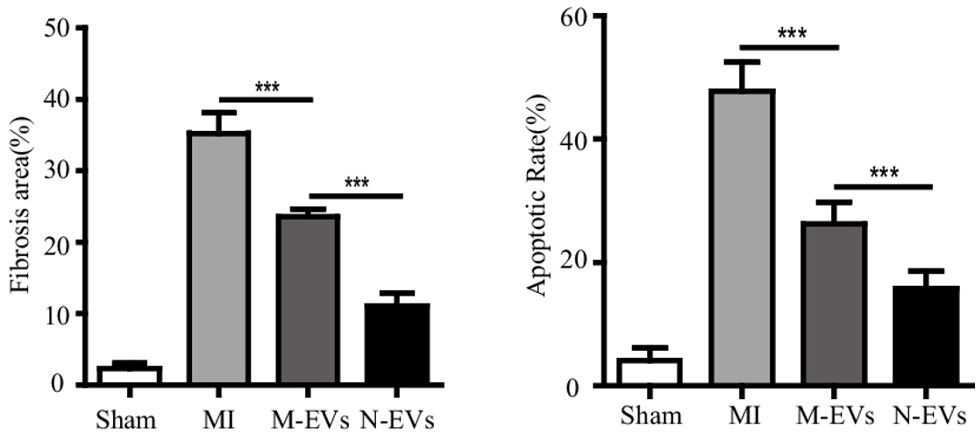
(Pu et al., 2023 | SCRR) NMN Conditioning Improves Stem Cell Vesicle-Mediated Heart Tissue Recovery. Following heart attack (MI), heart scar tissue size (Fibrosis area) % and heart cell death rate (Apoptosis Rate) % markedly increase relative to normal (Sham). Vesicles from stem cells (M-EVs) improve heart tissue remodeling, which is further enhanced when stem cells are first conditioned with NMN (N-EVs).
“Our study demonstrated that extracellular vesicles derived from [stem cells] could improve cardiac function by promoting [blood vessel formation], promoting proliferation, inhibiting apoptosis, reducing fibrosis, and improving cardiac function, which is further enhanced after NMN treatment,” say the authors.
A Future of NAD+-Enhanced Cell-Free Therapy
Stem cells have been applied to the treatment of many diseases, including neurological disease, respiratory disease, fracture healing, and cardiovascular disease. As increasing evidence shows that stem cell vesicles have similar effects, as well as advantages, we may see a shift in research towards so-called cell-free therapy, which is essentially stem cell therapy without the stem cells. Indeed, cell-free stem cell vesicles have been shown to alleviate arthritis and other age-related effects in rodents.
Pu and colleagues take cell-free therapy a step further by showing that NMN, an NAD+ booster, can enhance the therapeutic effects of stem cell-derived vesicles. Previous studies have shown that NMN rejuvenates stem cells, which could explain its enhancement effects. If cell-free therapy proves to be viable, it’s possible that NAD+ boosters or other stem cell rejuvenating drugs could promote the fitness of stem cells and their vesicles to enhance said therapy.
Story Source
Pu, Y., Li, C., Qi, X. et al. Extracellular Vesicles from NMN Preconditioned Mesenchymal Stem Cells Ameliorated Myocardial Infarction via miR-210-3p Promoted Angiogenesis. Stem Cell Rev and Rep (2023). https://doi.org/10.1007/s12015-022-10499-6
Scientists show that phthalate — a chemical used in toys, food packaging, and shampoo — induces features of oocyte aging that can be reversed by NMN.
When oocytes divide, spindles (green) normally attach to chromosomes (red) in an orderly fashion (left). However, phthalate causes spindle disorganization (right), which could lead to infertility.
By Victor Ciardha https://www.nmn.com/news/study-suggests-chemical-found-ubiquitously-in-consumer-products-induces-features-of-reproductive-aging-which-nmn-prevents
Highlights:
The female reproductive system ages faster than any other system in the body, and the ability of oocytes (eggs) to become fertilized declines with age. Thus, accelerating the age of oocytes can promote infertility. Now, a new study from Nanjing Medical University in China suggests that phthalates may accelerate oocyte aging, which could be reversed by NMN.
As reported in Cell Proliferation, Jiang and colleagues show that benzyl butyl phthalate (BBP) induces many common features of aging in mouse oocytes, including reduced fertilization rate. They then show that NMN prevents many of the underlying cellular features of phthalate exposure and aging, including DNA damage, mitochondrial damage, and cell death.
“These findings revealed a mechanism of BBP-induced toxicity on female reproduction and showed that NMN provides an effective treatment for BBP actions,” state Jiang and colleagues.
Chemical in Plastics Damages Oocytes
BBP is a chemical known as a plasticizer, which makes plastics more flexible. BBP is currently undergoing risk evaluation by the Environmental Protection Agency (EPA) and is regarded as an environmental pollutant because of its estrogenic activity. To determine the effects of BBP on female reproduction, Jiang and colleagues fed female mice 1.5 mg/kg of BBP for 8 days and compared them to female mice not exposed to BBP.
To test fertilization rate, the female mice were mated with male mice and their oocytes were removed for examination. While most of the oocytes from the mice not exposed to BBP developed into two-cell embryos, many of the oocytes from BBP-exposed mice went unfertilized. A lack of fertilized eggs suggests higher levels of infertility, the chances of which increase with age.
Aneuploidy — an abnormal number of chromosomes — is the leading cause of miscarriages and developmental disabilities. Aneuploidy is considered a hallmark of oocyte aging, because it increases by 50% with advanced age. Another feature of aging oocytes that leads to aneuploidy is poor spindle — proteins that help equally divide chromosomes — organization. Jiang and colleagues found that oocytes from BBP-exposed mice had both increased spindle disorganization and aneuploidy.
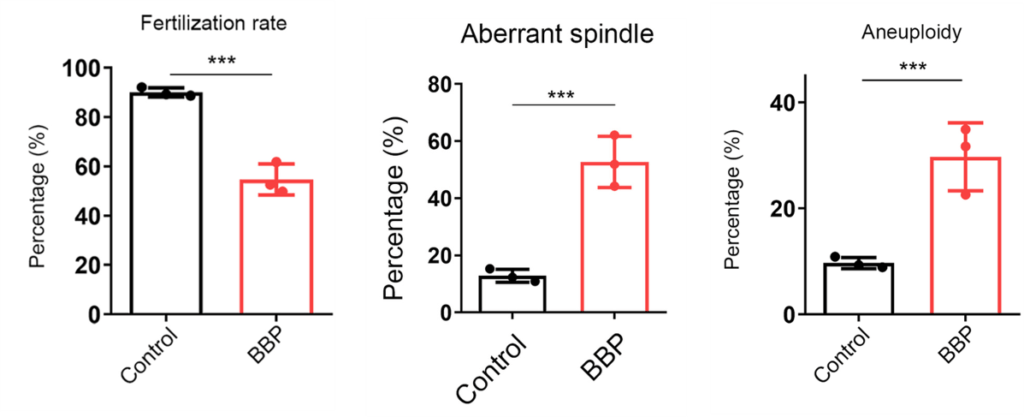
(Jiang et al., 2023 | Cell Proliferation) Phthalate Induces Oocyte Aging. Exposing mouse oocytes to benzyl butyl phthalate (BBP) induces common features of aging, including reduced fertilization rate, aberrant spindle formation, and aneuploidy when compared to normal oocytes (Control).
Cellular aging encompasses universal features that affect not only oocytes but all cells. These features include mitochondrial dysfunction. Mitochondria, like batteries, need to remain at a specific voltage to produce cellular energy. When mitochondria become unhealthy, as with aging, this voltage dissipates. Jiang and colleagues found that the mitochondria contained within the oocytes of BBP-exposed mice had reduced voltages, indicative of poor mitochondrial health. However, this reduction in voltage was reversed by injecting the mice with 200 mg/kg/day of NMN.
Unhealthy mitochondria produce excessive levels of reactive oxygen species (ROS). ROS react with proteins, fats, and DNA, causing damage to cells, a process called oxidative stress. Like mitochondrial dysfunction, oxidative stress is a universal hallmark of cellular aging. Jiang and colleagues found that oocytes from BBP-exposed mice had increased ROS levels, which were reduced to normal levels by NMN.
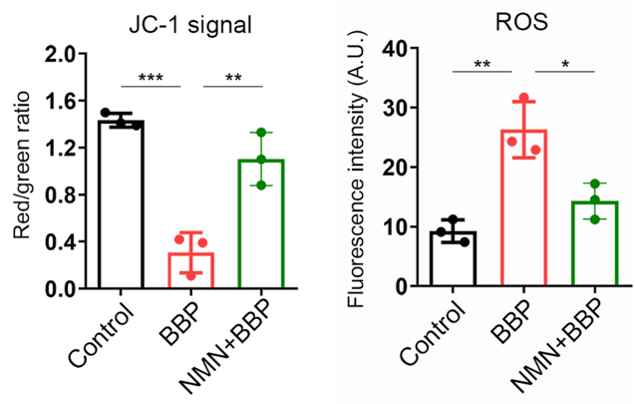
(Jiang et al., 2023 | Cell Proliferation) NMN Restores Mitochondrial Health. Compared to normal mouse oocytes (Control), oocytes exposed to benzyl butyl phthalate (BBP) display reduced mitochondrial health (JC-1 signal) and increased reactive oxygen species (ROS), cell-damaging molecules generated by unhealthy mitochondria. However, NMN prevents this mitochondrial dysfunction and ROS overproduction.
With aging, oxidative stress causes DNA damage that accumulates and leads to further decrements that exacerbate aging. Furthermore, when the voltage of damaged mitochondria reaches a specific threshold, cell death is activated. Jiang and colleagues found that both cell death and DNA damage were increased in the oocytes of BBP-exposed mice. Moreover, NMN prevented the occurrence of both of these aging features.

(Jiang et al., 2023 | Cell Proliferation) NMN Restores Cell Health. Compared to normal mouse oocytes (Control), oocytes exposed to benzyl butyl phthalate (BBP) display increased cell death (Apoptosis) and DNA damage. However, NMN prevents this cellular catastrophe.
Phthalates, Human Sperm and Muscle Aging, and How to Avoid Them
Recent studies have linked phthalates to male sperm aging and sarcopenia — the age-related loss of muscle mass and strength — in humans. Studies like these add to concerns of phthalate’s effects on our health, especially reproductive health. To address this concern, a recent study has outlined lifestyle interventions for reducing exposure to phthalate, as well as phenol, another endocrine-disrupting chemical found in many consumer products. One of the interventions is to replace items known to be a source of phthalate or phenol with other products. While knowing which products contain these chemicals may require investigation, the study provides common routes of exposure:
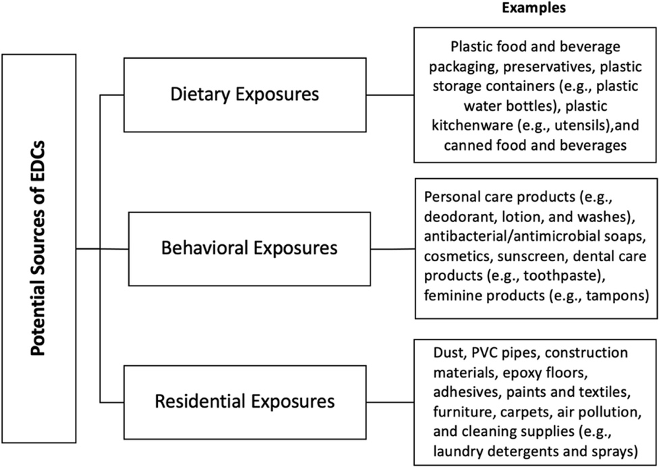
(Martin et al., 2022 | Environment International) Potential Sources of Endocrine-Disrupting Chemicals (EDCs) – phthalates and phenols.
While it is difficult to assess the level of BBP exposure for each individual, some foods have been found to have high levels of BBP, such as vegetable oil with 1.69 mg/kg in one study reported from China. A European study showed that minced meat has 0.078 mg/kg of BBP. Since Jiang and colleagues used 1.5 mg/kg of BBP in this study, these levels are above or near dangerous levels of BBP exposure.
Model and Dosage
Model: Female ICR mice
Dosage: 200 mg/kg/day of NMN intraperitoneally injected and 1.5 mg/kg/day of BBP by force feeding for 8 days
Story Source
Jiang Y, Wang D, Zhang C, Jiao Y, Pu Y, Cheng R, Li C, Chen Y. Nicotinamide mononucleotide restores oxidative stress-related apoptosis of oocyte exposed to benzyl butyl phthalate in mice. Cell Prolif. 2023 Feb 9:e13419. doi: 10.1111/cpr.13419. Epub ahead of print. PMID: 36756972.
Journal Reference
Moghadam ARE, Moghadam MT, Hemadi M, Saki G. Oocyte quality and aging. JBRA Assist Reprod. 2022 Jan 17;26(1):105-122. doi: 10.5935/1518-0557.20210026. PMID: 34338482; PMCID: PMC8769179.
Igarashi H, Takahashi T, Nagase S. Oocyte aging underlies female reproductive aging: biological mechanisms and therapeutic strategies. Reprod Med Biol. 2015 May 9;14(4):159-169. doi: 10.1007/s12522-015-0209-5. PMID: 29259413; PMCID: PMC5715832.
Wasielak-Politowska M, Kordowitzki P. Chromosome Segregation in the Oocyte: What Goes Wrong during Aging. Int J Mol Sci. 2022 Mar 7;23(5):2880. doi: 10.3390/ijms23052880. PMID: 35270022; PMCID: PMC8911062.
Chinese scientists find that NMN protects against intestinal infection in sleep-deprived mice and elevates an antibacterial bile salt that increases the survival of infected moth larvae.
Senior author, Dr. Yuan Liu | Revive
By Victor Ciardha Published: 10:02 am PST Feb 7, 2023 | Updated: 4:43 p.m. PST Feb 7, 2023
Highlights:
Sleep deprivation (SD) can lead to cardiovascular disease, cognitive impairment, and intestinal infection. Thus, finding ways to mitigate the adverse effects of SD is critical for health and longevity.
“According to the World Health Organization (WHO), intestinal infections annually kill more than two million people worldwide, most of whom are children,” state Fang and colleagues, the authors of a new study from Yang Zhou University in China.
Fang and colleagues have found that NMN fights against intestinal infections. The researchers report in Advanced Science that NMN ameliorates SD-induced gut bacteria changes in mice. NMN also reduces infection and increases a bile salt called DCA. They go on to show that DCA has antibacterial properties that increase the survival rate of infected mice.
NMN Protects Against Intestinal Infection
To establish an SD mouse model, Fang and colleagues used a continuously rotating machine to interfere with mice and prevent them from sleeping for three days. During these three days, 100 mg/kg of NMN was fed to the mice. To induce intestinal infection, the mice were force-fed pathogens, including a bacteria called MRSA T144. As a result, the SD mice had a 10 to 1000-fold higher fecal load of pathogens, which was prevented by NMN. NMN also reduces the inflammatory response to infection.
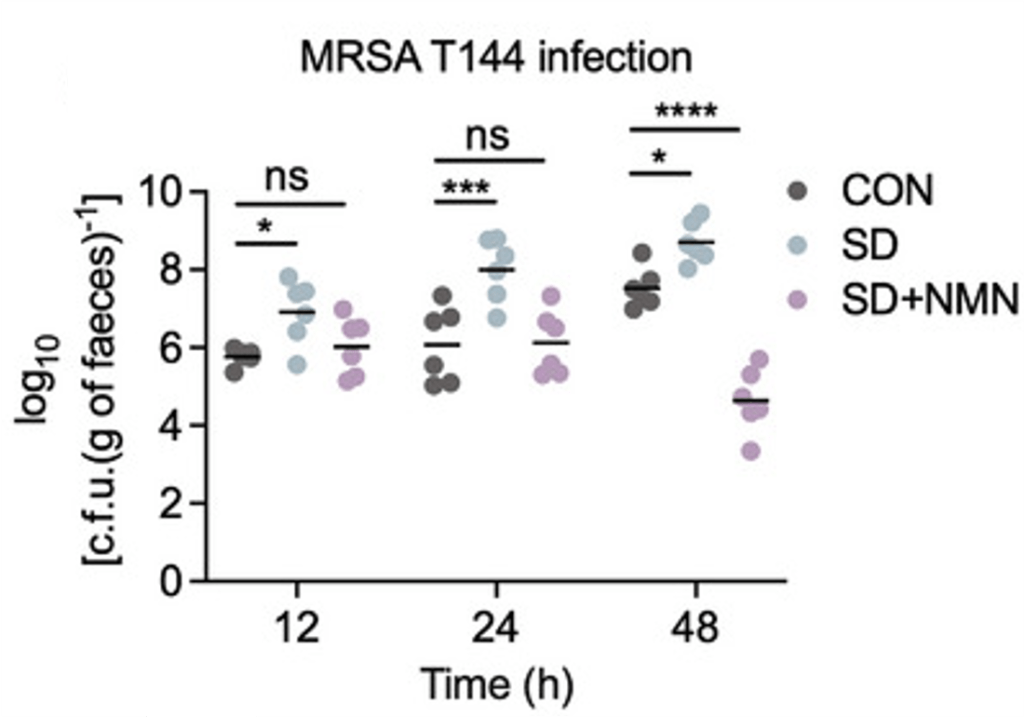
(Fang et al., 2023 | Advanced Science)
NMN Prevents Infection Caused by Sleep Deprivation (SD). Compared to normal mice (CON), SD mice have increased infection (c.f.u./g of faeces) from MRSA T144 bacteria. However, NMN (SD+NMN) prevents this infection.
To determine how NMN could reduce intestinal infection, Fang and colleagues measured gut bacteria metabolites from NMN-treated SD mice. They found that the bacterial production of a bile salt derivative called deoxycholic acid (DCA) was increased by NMN. Further experiments showed that DCA has potent antibacterial activity, and treating moth larvae with DCA for three days increased their survival by 50% when combined with the antibiotic ciprofloxacin (CIP).
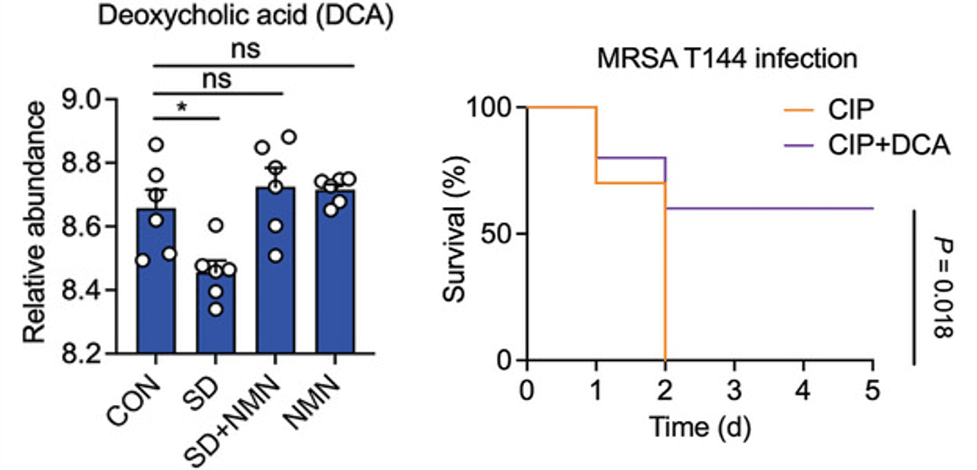
(Fang et al., 2023 | Advanced Science)
NMN Restores Life-Extending Antibacterial Metabolite Deoxycholic Acid (DCA) in SD Mice. Left:Compared to normal mice (CON), SD mice have low DCA (Relative abundance), which is restored by NMN (SD+NMN). Right: Treating MRSA T144-infected moth larvae with DCA and the antibiotic CIP increases survival by 50%.
NMN for Intestinal Health
NMN has previously been shown to restore the structural integrity of the intestine by boosting antioxidant defenses and reducing inflammation in older mice. NAD+, which is elevated by NMN, also acts as an antioxidant in sleep-deprived fly intestines, which increases their lifespan. Furthermore, NMN has been shown to improve gut bacteria composition in mice. These studies are supported by the findings of Fang and colleagues, who now show that NMN has antibacterial effects. While human studies are needed, it seems that NMN could improve intestinal and gut bacteria health from multiple angles.
Model and Dosage
Model: 8-week-old female BALB/c mice
Dose (oral): 100 mg/kg NMN during a three-day sleep deprivation period
Story Source
Fang D, Xu T, Sun J, Shi J, Li F, Yin Y, Wang Z, Liu Y. Nicotinamide Mononucleotide Ameliorates Sleep Deprivation-Induced Gut Microbiota Dysbiosis and Restores Colonization Resistance against Intestinal Infections. Adv Sci (Weinh). 2023 Jan 25:e2207170. doi: 10.1002/advs.202207170. Epub ahead of print. PMID: 36698264.
NMN prevents chemo-induced mitochondrial defects, such as DNA damage and low cellular energy in neurons derived from human stem cells, a step forward in treating chemo-induced cognitive impairment.
By Victor Ciardha Source: https://www.nmn.com/news/mayo-clinic-scientists-find-nmn-protects-against-chemo-induced-mitochondrial-dysfunction-in-human-neurons
Highlights:
“Chemobrain” is a term used to describe chemotherapy-induced cognitive impairment, which includes impaired memory, attention, and information processing. Up to 60% of chemotherapy patients experience chemobrain years following treatment. Still, there remain no effective treatments due to an unclear understanding of the processes that underlie chemobrain.
Now, researchers from the Mayo Clinic present in Brain Plasticity evidence suggesting NMN can prevent chemobrain by restoring mitochondrial function. In human neurons, Rashid and colleagues show that NMN mitigates cisplatin-induced cellular defects like DNA damage. Furthermore, NMN prevents cisplatin-induced disruptions in mitochondrial function and structure. The findings elucidate the cellular underpinnings of previous findings showing that NMN alleviates chemo-induced memory loss.
Cisplatin is capable of binding to mitochondrial DNA, the DNA found in mitochondria important not only for mitochondrial function but cellular function as well. Cisplatin binding to DNA causes DNA damage and increases the generation of mitochondrial reactive oxygen species (mROS). mROS are highly reactive molecules that, in excessively high concentrations, cause damage to cells — oxidative stress.
To study the effect of NMN on cisplatin-exposed human neurons, Rashid and colleagues took stem cells from a 16-year-old male and chemically transformed them into cortical neurons. The neurons were pretreated with NMN for thirty minutes before being exposed to cisplatin for twenty-four hours. The results showed that with NMN pretreatment, cisplatin-induced DNA damage and increases in mROS were greatly reduced.
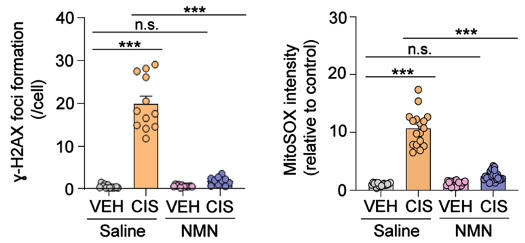
(Rashid et al., 2023 | Brain Plasticity) NMN Reduces DNA Damage and Mitochondrial Reactive Oxygen Species (mROS). In neurons treated with cisplatin (CIS) and saline (orange), DNA damage (𝛾-H2AX foci formation) and mROS (MitoSOX intensity) are greatly increased. However, NMN (blue) largely prevents these cellular defects.
Mitochondria convert oxygen and nutrients into adenosine triphosphate (ATP), a chemical cells use for energy. As impaired mitochondria generate excessive mROS, the resulting oxidative stress dissipates the electrochemical gradient that allows mitochondria to produce ATP, leading to reduced ATP production.
To assess the health of the mitochondrial electrochemical gradient, Rashid and colleagues measured the mitochondrial membrane potential, essentially the voltage of mitochondria. They found that cisplatin reduced both the membrane potential and level of ATP in human neurons. However, this was prevented by NMN pretreatment.
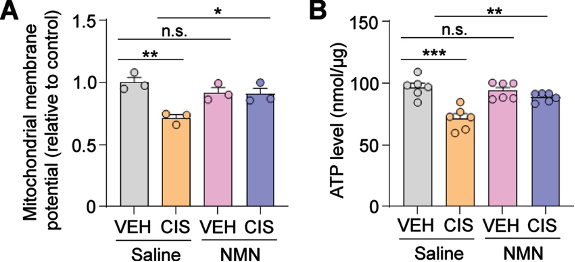
(Rashid et al., 2023 | Brain Plasticity) NMN Prevents Mitochondrial Dysfunction. In neurons treated with cisplatin (CIS) and saline (orange), the mitochondrial membrane potential (A) and ATP levels (B) are reduced. However, NMN (blue) prevents these measures of mitochondrial dysfunction.
A structural feature of mitochondria in response to neural injury is their swelling. Rashid and colleagues measured mitochondrial swelling by assessing the size of mitochondria under a powerful (transmission electron) microscope. Cisplatin caused an increase in mitochondrial area, which was prevented by NMN, suggesting the prevention of swelling.
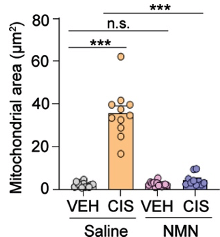
(Rashid et al., 2023 | Brain Plasticity) NMN Prevents Mitochondrial Structural Changes. In neurons treated with cisplatin (CIS) and saline (orange), the mitochondrial area is increased, indicative of mitochondrial swelling and neural injury. However, NMN (blue) prevents this increase in mitochondrial size.
Mitochondrial impairments are prominent features of brain aging and neurodegeneration that underlie cognitive impairment. Thus, the findings of Rashid and colleagues suggest that NMN can potentially aid in preventing brain aging and neurodegeneration, especially in response to chemotherapies like cisplatin.
NMN has also been shown to prevent heart damage in response to doxorubicin, a chemotherapy for cancers like leukemia, and protect against intestinal wall injury in response to radiation therapy, commonly used to treat abdominal and pelvic tumors in older individuals. Thus, with more studies, we may see more evidence showing that NMN can prevent the side effects of various cancer therapies.
Story Source
Rashid MA, Oliveros A, Kim YS, Jang MH. Nicotinamide Mononucleotide Prevents Cisplatin-Induced Mitochondrial Defects in Cortical Neurons Derived from Human Induced Pluripotent Stem Cells. Brain Plast. 2022 Dec 20;8(2):143-152. doi: 10.3233/BPL-220143. PMID: 36721392; PMCID: PMC9837732.
A new study has revealed that restoring NAD+ levels in the aging brain may be possible through the use of nicotinamide mononucleotide (NMN) or small vesicles containing the NAD+ synthesizing enzyme NAMPT (eNampt). The research, conducted by scientists at Washington University, showed that treating aged mice with NMN or eNampt led to increased NAD+ levels in various regions of the hypothalamus, a brain region responsible for maintaining overall health and homeostasis.
The study utilized a novel method to accurately measure NAD+ levels in the small subregions of the hypothalamus, and the results showed that NAD+ levels decline significantly in three of the four measured areas in aged mice. The researchers found that a single shot of 300 mg/kg of NMN was enough to restore NAD+ levels in all three regions. Injecting aged mice with small vesicles from young mice containing NAMPT also resulted in nearly a 50% increase in NAD+ levels in the hypothalamus.
The findings of the study open up the possibility of future research on the effects of reduced NAD+ in the hypothalamus and other brain regions. The results also confirm that NMN is an effective method of replenishing NAD+ levels in the hypothalamus of aged mice, which can help maintain brain health and prevent cognitive decline.
In conclusion, the study highlights the importance of NAD+ in preserving brain health, especially in aging. The new method of measuring NAD+ levels in small tissues and the positive results of NMN supplementation offer hope for the future of brain health and wellness.

(Imai et al., 2023 | NPJ Aging) NMN attenuates falling NAD+ levels in four subregions of the hypothalamus. (Left) compared to young mice (grey), aged mice (white) show declining NAD+ levels in the arcuate nucleus (ARC), ventromedial hypothalamus (VMH), and lateral hypothalamus (LH) of the hypothalamus. (Right) NMN (white) increases NAD+ levels in all four hypothalamic subregions: ARC, VMH, LH, and dorsomedial hypothalamus (DMH).
NAMPT-Containing Vesicles Boost Hypothalamic NAD+ Levels
NAMPT has been widely recognized as an effective NAD+ booster in various tissues and a promoter of longevity. Previous studies have shown that transplanting small vesicles from young mice into aged mice can increase NAD+ levels and extend lifespan. With this in mind, the researchers, Imai and colleagues, aimed to investigate the effects of similar vesicles on NAD+ levels in the hypothalamus.
The results showed that injecting aged mice with vesicles containing NAMPT from young mice resulted in a substantial increase in NAD+ levels in the hypothalamus. These findings suggest that these vesicles have potent NAD+-enhancing properties in the hypothalamus and raise the possibility that this treatment could reverse age-related changes in sensory processing and emotional control in the hypothalamus.
In conclusion, NAMPT-containing vesicles hold promise as a treatment for boosting NAD+ levels in the hypothalamus and may have potential for alleviating age-related changes in the brain. Further research is needed to fully understand the impact of this treatment on aging and brain health.
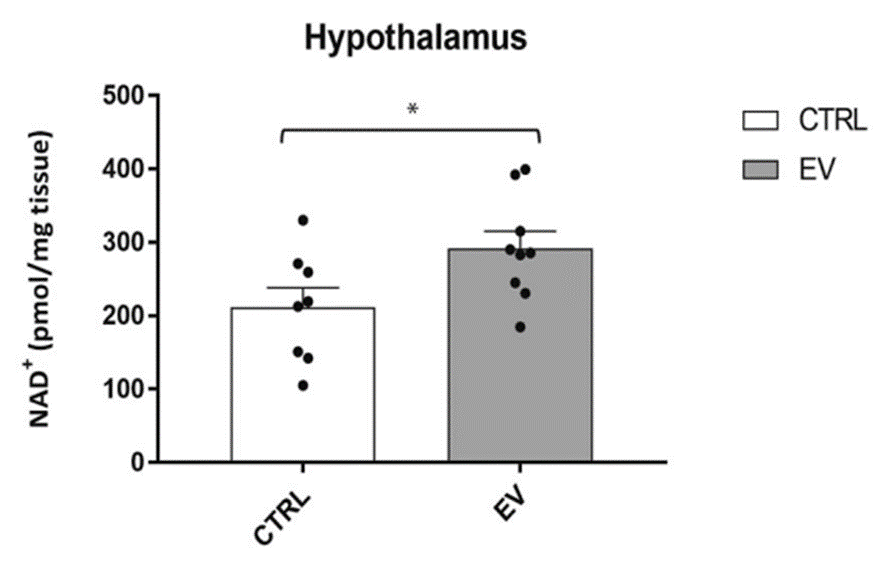
(Imai et al., 2023 | NPJ Aging) NAMPT-containing vesicles raise hypothalamic NAD+ levels. Compared to untreated controls (CTRL), aged mice treated with NAMPT-containing vesicles from young mice (EV) have around 50% more hypothalamic NAD+.
NMN and eNAMPT as Possible Treatments for Brain Aging
Thanks to the new method developed by Imai and colleagues for accurately measuring hypothalamic NAD+ levels, we now have the means to monitor brain aging and potentially discover new therapies. Our brains inevitably suffer a decline in function as we age, due to constant damage from stressors like inflammation and DNA damage, which rely on NAD+ for protection. Therefore, finding ways to increase NAD+ in various tissues is critical to slowing down aging and preserving organ function.
The study results show that NMN and eNAMPT can effectively raise NAD+ levels in the aged hypothalamus, suggesting that these treatments could mitigate the effects of brain aging, such as poor sleep, decreased physical ability, and diminished cognition. However, further research is needed to validate these findings.
Model and Dosage
Model: C57BL/6J mice
Dosage: 300 mg/kg NMN intraperitoneal injection at 22 months of age
Story Source
Johnson, S., Yoshioka, K., Brace, C.S. et al. Quantification of localized NAD+ changes reveals unique specificity of NAD+ regulation in the hypothalamus. npj Aging 9, 1 (2023). https://doi.org/10.1038/s41514-023-00098-1
https://www.nmn.com/news/washington-university-study-shows-nmn-replenishes-nad-in-the-aging-brain
Scientists in China show that NMN increases intestinal mucus secretion, repairs the intestinal wall, and promotes probiotic growth in a mouse model for inflammatory bowel disease.
By Victor Ciardha Original Article: www.nmn.com
Highlights:
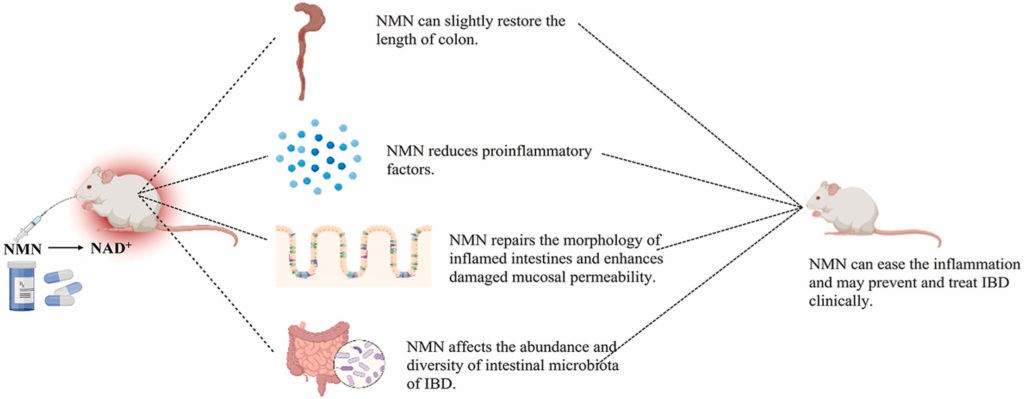
Summary of Findings. When mice modeling IBD are fed NMN, the length of their colon increases, their intestines become less inflamed, their intestinal wall becomes less permeable, and the composition of their gut bacteria improves.
Aside from pleasure, the food we eat is useless unless the nutrients it contains are absorbed through our intestinal wall. Furthermore, if our intestinal wall is leaky, unwanted molecules can sneak into our bloodstream and harm our tissues and organs. This poor nutrient absorption and leaky intestinal wall are characteristic of inflammatory bowel disease (IBD), a disease on the rise within the aging population.
Now, researchers from Jiangsu University in China report in Current Research in Food Science that NMN could treat IBD. Huang and colleagues show mice that model IBD have poor mucus secretion, heightened inflammation, and intestinal wall leakage. Feeding NMN to these IBD mice increases their mucus secretion, hampers inflammation, and repairs the intestinal wall. Furthermore, beneficial gut bacteria flourish as harmful gut bacteria dwindle when NMN is fed to IBD mice.
NMN Repairs the Intestinal Wall and Recomposes Gut Bacteria
Our intestinal wall is a barrier that prevents toxins and bacteria from entering our bloodstream. This barrier includes mucus secreted by specialized (goblet) cells. To establish a model for IBD, Huang and colleagues placed a toxic carbohydrate called dextran sodium sulphate (DSS) into the drinking water of mice. The DSS mice displayed impaired intestinal wall mucus secretion, as shown by a dye that stains mucus blue. Feeding DSS mice NMN restored much of this mucus secretion, suggesting NMN improves the protective layer of mucus lining the intestinal wall.
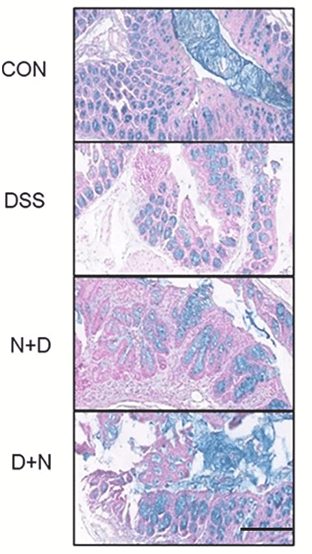
NMN Restores Intestinal Wall Mucus Secretion. Mice that model IBD (DSS) display less intestinal mucus (blue) than normal mice (CON). Treatment with NMN for 14 (D+N) and 21 (N+D) days restores much of this mucus secretion.
To test the effects of NMN on intestinal wall leakage, Huang and colleagues fed mice a small fluorescent molecule capable of permeating the gut wall. When the intestinal wall is damaged, this molecule can leak into the bloodstream and be imaged. When imaged, the DSS mice displayed body-wide fluorescence of this molecule, indicating a leaky gut. Treating DSS mice with NMN limited fluorescence to the gut region, indicating that NMN reduces gut barrier damage and permeability.

NMN Reduces Intestinal Wall Leakage. Mice modeling IBD (DSS) display high levels of gut barrier leakage (red) compared to normal mice (CON). Treatment with NMN (D + N, N +D) prevents much of this leakage, as shown by decreased red fluorescence.
Our gut contains different species of bacteria, some of which are beneficial to us and protect gut barrier function and some that are harmful to our intestinal wall. Huang and colleagues showed that DSS mice had altered gut bacteria abundance. However, treatment with NMN increased the abundance of beneficial bacteria (Firmicutes, Verrucomicrobia, Akkermansia, and Lactobacillus), demonstrating that NMN could treat IBD-induced gut bacterial changes.
NMN and the Aging Intestine
The findings of Huang and colleagues suggest that NMN could at least partially treat IBD, an inflammatory disease. Since inflammation underlies many age-related disorders, based on these results, it’s possible that NMN could also treat the decline of the intestine that occurs with natural aging. Other studies have shown that NMN reverses age-related gut barrier weakness in mice and increases the survival of mice modeling IBD. Furthermore, it was shown that NMN protects the intestinal wall by altering gut bacteria diversity. Together, these animal studies suggest that NMN can treat intestinal aging.
Source
Pan Huang, Xuxin Wang, Siyu Wang, Zhipeng Wu, Zhengrong Zhou, Genbao Shao, Caifang Ren, Meiqian Kuang, Yan Zhou, Anqi Jiang, Weihong Tang, Jianye Miao, Xin Qian, Aihua Gong, Min Xu. Treatment of inflammatory bowel disease: Potential effect of NMN on intestinal barrier and gut microbiota. Current Research in Food Science, Volume 5, 2022, Pages 1403 1411. ISSN 2665-9271. https://doi.org/10.1016/j.crfs.2022.08.011.